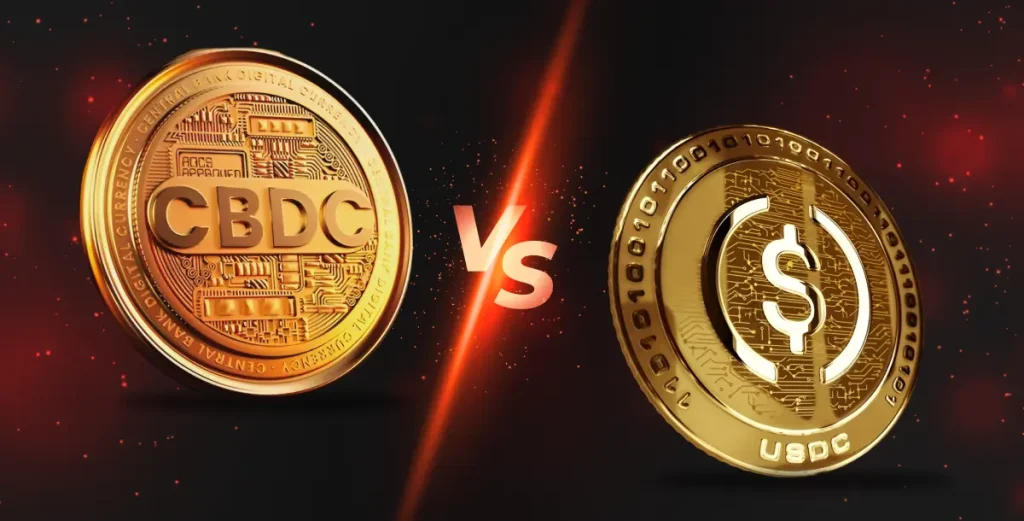The digital money revolution is creating two distinct paths forward. On one side, private companies issue stablecoins backed by traditional assets. On the other hand, central banks develop their own digital currencies, known as Central Bank Digital Currencies (CBDCs), with sovereign backing.
Both stablecoins and CBDCs promise faster payments, lower costs, and increased financial inclusion. But they represent fundamentally different approaches to money’s future. Private innovation versus government control, and market forces versus monetary policy.
Understanding the difference between stablecoins and CBDCs matters more than ever. Countries worldwide are piloting digital currencies while stablecoin usage explodes. The choices made today will shape how we pay, save, and interact with money for decades.
This guide breaks down everything you need to know about stablecoins vs CBDCs, from technical differences to real-world applications.
What Are Stablecoins and CBDCs?
Stablecoins are digital currencies issued by private entities and pegged to the value of traditional assets like fiat currency (e.g., the US dollar), government bonds, or commodities like gold. Popular examples include USDC (Circle) and USDT (Tether), which are fiat-backed, and DAI (MakerDAO), which is crypto-backed. They maintain stable value through various mechanisms and operate on public blockchains.
Central Bank Digital Currencies (CBDCs) are digital versions of a national fiat currency issued directly by central banks. Unlike cryptocurrencies, CBDCs represent a government-backed form of money with the full backing of a central bank’s monetary policy. China’s digital yuan (e-CNY) and the Bahamas’ Sand Dollar are leading examples.
Both aim for price stability in the digital realm, but their control structures couldn’t be more different.
| Feature | Stablecoins | CBDCs |
| Issuer | Private entities (Circle, Tether) | Central banks (Federal Reserve, European Central Bank) |
| Backing | Fiat currency, bonds, or other assets | Sovereign fiat currency (the “full faith and credit” of a government”) |
| Purpose | Trading, DeFi, cross-border payments | Monetary policy, financial inclusion, payment system modernization |
| Control | Market-driven governance, smart contracts | Government-issued and centrally regulated |
| Transparency | Varies by issuer; can be subject to third-party audits | Fully monitored by authorities; can offer varying degrees of privacy |
The Key Difference Between Stablecoins and CBDCs
At their core, the stablecoins vs CBDCs debate represents a choice between decentralized innovation and centralized control.
Stablecoins embody private sector innovation. They operate on open blockchain networks, integrate with decentralized finance (DeFi) protocols, and respond to market demands. Users can trade them 24/7, use them in smart contracts, and move them across borders without traditional banking infrastructure.
CBDCs represent sovereign digital money. Central banks issue them to maintain monetary control, implement policy more effectively, and ensure financial stability. They offer programmable money that governments can use for targeted stimulus, tax collection, or economic monitoring.
The philosophical divide runs deep. Stablecoins prioritize financial freedom and innovation, while CBDCs emphasize stability and regulatory oversight. Each serves different needs in the evolving digital economy.
How Stablecoins and CBDCs Work
Stablecoin Architecture
Most stablecoins operate as tokens on public blockchains like Ethereum or Solana. They maintain stability through several mechanisms:
- Fiat-backed stablecoins: The most common type, these hold traditional currency reserves (like U.S dollars or government bonds) equal to circulating tokens. Examples include USDC and USDT.
- Crypto-backed stablecoins: These are over-collateralized by other volatile cryptocurrencies to mitigate price fluctuations. DAI is a prime example, backed by a mix of digital assets.
- Algorithmic stablecoins: These rely on smart contracts and market incentives to automatically adjust the token’s supply based on demand, without holding direct collateral. This model has faced significant challenges, as seen with the collapse of TerraUSD (UST).
Smart contracts manage issuance, redemption, and transfers. Third-party auditors typically verify reserve holdings for fiat-backed stablecoins, though transparency varies significantly between issuers.
CBDC Technical Design
CBDCs use different technical approaches depending on their intended use:
- Retail CBDCs are for consumer payments and are a digital version of cash, accessible to the public. They can use a centralized database or a form of distributed ledger technology (DLT).
- Wholesale CBDCs are for transactions between financial institutions and are designed to improve efficiency in interbank settlements. They often leverage DLT for this purpose.
- Hybrid models combine centralized issuance by the central bank with an intermediary role for private financial institutions in managing accounts and payments.
Central banks maintain full control over issuance, distribution, and monetary policy integration. They can program features like expiration dates, spending restrictions, or targeted distribution directly into the currency.
Stablecoins vs CBDCs in 2025: Global Developments
The CBDC vs stablecoin landscape varies dramatically by region, with different approaches shaping the future of digital money.
United States: On July 18, 2025, President Donald Trump signed the Guiding and Establishing National Innovation for U.S. Stablecoins Act (GENIUS Act) into law. This landmark legislation created the first-ever comprehensive federal regulatory framework for payment stablecoins. The GENIUS Act defines a payment stablecoin, requires 1:1 reserve backing with high-quality liquid assets like U.S. dollars and short-term Treasuries, and sets standards for public disclosure of reserve holdings. While the Federal Reserve continues researching CBDCs, the GENIUS Act provides regulatory clarity for stablecoin issuers, solidifying the role of private digital dollars like USDC and PYUSD in the U.S. financial system.
Europe: The European Central Bank is advancing its digital euro project with a focus on strict privacy protections and offline functionality. The Markets in Crypto-Assets (MiCA) regulations provide clear guidelines for stablecoin operations across EU member states, positioning Europe as a leader in stablecoin regulation.
Asia-Pacific: China leads CBDC adoption with its digital yuan, while countries like Singapore and Japan are piloting interoperable systems. These countries are actively testing how CBDCs can work alongside regulated stablecoins for more efficient cross-border payments.
Emerging Markets: Countries like Kazakhstan are experimenting with both approaches simultaneously. They’re testing a digital tenge CBDC while supporting stablecoin projects like Evo for regional trade and remittances.
These regional differences highlight how stablecoins vs CBDCs isn’t a zero-sum game. Different economic needs drive different solutions.
Use Cases: Where Each Digital Currency Excels
When analyzing stablecoins vs CBDCs in real-world applications, both offer unique advantages for specific use cases.
| Use Case | Stablecoins | CBDCs |
| Cross-border payments | Fast, low-cost, 24/7 availability for peer-to-peer or business transactions. | Direct central bank clearing, reduced reliance on intermediary banks. |
| Retail payments | Wallet-driven adoption, and integration with merchants and online platforms. | Government-backed reliability, legal tender status, and universal acceptance. |
| Monetary policy | Limited direct policy transmission due to private issuance. | Real-time policy implementation, and the ability to issue targeted stimulus. |
| Financial inclusion | Platform-dependent access for the unbanked and underbanked. | Designed for national reach, government-backed infrastructure. |
| DeFi integration | Native blockchain compatibility for lending, yield farming, and other protocols. | Limited programmability, and potential regulatory restrictions on use. |
Stablecoins excel in permissionless environments where speed and innovation matter most. They integrate seamlessly with decentralized applications, enable complex financial products, and operate across multiple blockchain networks.
CBDCs shine when government backing and policy integration are priorities, providing a secure, universal digital payment rail for a country’s citizens.
The Pros and Cons of Stablecoins vs CBDCs
Stablecoin Advantages
- Innovation: Rapid development cycles and integration with emerging technologies
- Global reach: Borderless transfers without traditional banking infrastructure
- DeFi compatibility: Native support for lending, yield farming, and complex financial products
- 24/7 availability: Always-on systems without banking hours restrictions
Stablecoin Challenges
- Depegging risk: Market stress or mismanagement can cause a stablecoin to lose its peg to the underlying asset
- Regulatory uncertainty: Evolving and often inconsistent compliance requirements across jurisdictions
- Transparency issues: Reserve auditing and disclosure practices vary widely
- Counterparty risk: Dependence on private issuers and their financial health
CBDC Advantages
- Government backing: Full faith and credit of sovereign nations
- Policy integration: Direct monetary policy transmission and economic monitoring
- Universal access: Designed for broad population coverage and financial inclusion, often serving as a digital alternative to cash.
- Regulatory clarity: Clear legal status as legal tender
CBDC Challenges
- Privacy concerns: Potential for comprehensive government transaction monitoring
- Innovation constraints: Slower development cycles and limited private sector involvement can stifle innovation
- Infrastructure requirements: Significant investment in new systems to issue and manage the digital currency
- Disintermediation risk: Potential disruption to traditional banking systems
The comparison of stablecoins vs CBDCs shows that each model carries tradeoffs between speed, control, and transparency. Neither offers a perfect solution for all use cases.
The Future of Digital Money: Coexistence, Not Competition
Rather than competing directly, stablecoins and CBDCs are likely to coexist in complementary roles. The future financial system may feature multiple layers of digital money serving different purposes.
CBDCs will anchor national monetary systems, providing a stable, risk-free foundation for domestic payments and policy implementation. They’ll offer the reliability and backing that only governments can provide.
Stablecoins will continue driving innovation in global payments, DeFi, and cross-border commerce. They’ll serve as bridges between different blockchain ecosystems and traditional finance.
Interoperability will become crucial. Technical standards and compliance frameworks are already emerging to enable seamless transfers between different digital currency systems. This hybrid approach maximizes the benefits of both models while minimizing their individual limitations.
What the Stablecoins vs CBDCs Debate Means for Financial Institutions and Businesses
The evolution of digital money fundamentally changes how financial institutions operate and how businesses manage transactions. Banks must prepare for a future where CBDCs reduce their role in payments while stablecoins create new financial services. The institutions that thrive will embrace both models, building bridges between traditional and digital finance. Fintech companies, including payment processors and wallet providers, have opportunities to create infrastructure that supports this diverse digital currency ecosystem.
For businesses, the mainstream adoption of digital currencies necessitates significant operational changes. Companies will need to update their payment systems, compliance procedures, and treasury management practices to handle multiple forms of digital money. Preparing for these shifts will be crucial for navigating the evolving financial landscape and leveraging the benefits of both stablecoins and CBDCs, with support from innovative digital asset solution providers that facilitate seamless adoption and integration.




